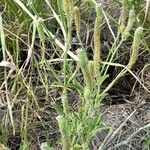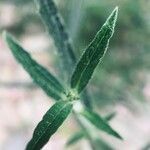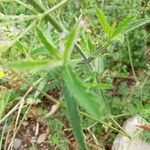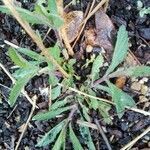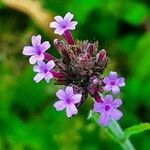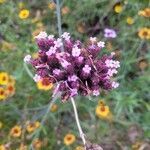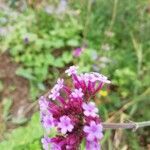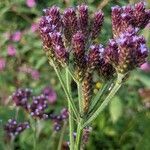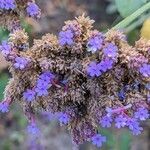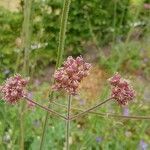Perennial; stems hairy or scabrid, erect, ± square, to c. 3 m tall. Lvs sessile, 3-17 × 1-6 cm, oblong-lanceolate to ovate, coarsely and irregularly toothed, strigose with bulbous-based hairs denser above than below; veins strongly impressed above; base usually amplexicaul, sometimes subcordate or cordate; apex acute. Infl. much-branched, densely hairy, composed of spikes; spikes closely packed, 0.8-3 cm long at maximum flowering, not elongating much at fruiting, rather stout; fls dense. Bracts ± = or slightly > calyx, lanceolate, hairy, keeled. Calyx c. 3 mm long, hairy, purple, ± glandular-scaly; teeth acuminate or acute, similar to bracts. Corolla tube nearly 2× length of calyx, hairy outside; limb 2-3 mm diam., mauve or purplish, often drying deep blue. Nutlets 1-1.5 mm long, oblong, brown on dorsal surface, longitudinally ribbed, white-papillate on flattened ventral surface.
Herb 0.6–2 m high; branches erect, conspicuously quadrangular, slightly scabrous. Leaves sessile, narrowly oblong-ovate, 4–22 cm long, 0.6–7 cm wide, rugose, scabrid and ±villose above, tomentose below; base subcordate and partly clasping branch; margin coarsely incised-serrate; apex acuminate. Inflorescence a lax terminal corymb with long branches ending in a dense spike; bracts equal to or shorter than calyx. Calyx 5-toothed, 2.5–3.5 mm long, glandular-pubescent, hispidulous along ribs. Corolla blue, dark violet-purple or lavender-pink, scarcely 2 times as long as calyx; tube (3.5–) 4–8 mm long. Mericarps 1.5–1.8 mm long.
Perennial herb, 1-2 m high; ascending erect, 4-angled; scabrid, hairs bristle-like intermixed with glandular hairs. Leaves ovate-lanceolate to oblong, 50-120 x 30 mm, base semi-amplexicaul, apex acute, margins serrate to double serrate; scabrid with patent tubercle-based hairs above, indumentum densest below. Inflorescence of many, cymosely arranged spikes, in dense flat-topped or rounded clusters; bracts lanceolate, attenuate. Flowers deep purple. Calyx 30-35 mm long. Corolla: tube exserted from calyx; limb ± 3 mm in diam. Flowering time Oct.-Mar. Fruit of 1.5-2.1 mm long mericarps.
Leaves (3)5–12(17.5) cm long and up to 3 cm wide, ovate, ovate-lanceolate or oblong, acute at the apex, narrowed above the base and enlarged below into a subauriculate, semiamplexicaul base, serrate to double serrate at the margin, the base sometimes entire; lamina stiff, scabrid with patent acicular tubercle-based hairs, the indumentum densest beneath particularly on the nervation; midrib and nervation impressed above, raised beneath; the upper leaves 7–10.5 cm long and narrowly oblong to linear-lanceolate, the uppermost becoming bract like, sometimes the uppermost entire.
Inflorescence of numerous spikes in a dense flat-topped or rounded cluster, the spikes cymosely arranged and mostly in dense groups of triads; spikes densely flowered, up to 4.5 cm long and 4–7 mm thick, ovoid becoming cylindric in fruit, the central one sessile, the lateral ones subsessile; bracts usually a little shorter than the calyx, 2.5–3(4) mm long, lanceolate, attenuate towards the acute apex, pilose with some minute glandular hairs intermixed, ciliate on the margins.
Perennial herb, up to 2 m high. Stems stiffly erect, strongly 4-angled. Leaves simple; sessile; blade ovate, narrowly ovate or oblong, 50-120 x 5-30 mm, amplexicaul, margins dentate to incised-serrate. Flowers: in many spikes, spikes in a dense flat-topped or rounded cluster; uppermost corolla limbs overtopping spike; floral bracts slightly shorter than calyces; corolla tube up to 5.5 mm long, corolla blue or mauve; Oct.-May.
Stem simple or little-branched, ascending-erect, strongly 4-angled, with pale ribbed angles and flattish faces, somewhat constricted just below the nodes, scabrid to hispid or hirsute; branches mostly 5–9 cm long; indumentum sparse, consisting of spreading bristle-like hairs, sometimes intermixed with short glandular hairs.
Perennial herb, up to 2 m high. Leaves dentate to incised-serrate, sessile, amplexicaul. Spikes very dense, mostly sessile and crowded. Bracts equalling or shorter than calyx. Inflorescence not glandulose. Flowers blue or mauve.
Corollas deep purple, the uppermost overtopping the spike; tube (3.25)3–4.75(5–5.5) mm, exserted above the calyx teeth for (0.5)0.75–1.5 mm; limb c. 3 mm in diameter.
Calyx (2.5)3–3.5 mm long, hispidulous outside with small glandular hairs intermixed.
Stamens inserted near middle of the corolla tube; anthers 0.5 mm long.
Stiffly erect perennial herb up to 2.5 m tall.
Mericarps 1.5–2.1 mm long.
Style (1.25)1.5 mm long.
